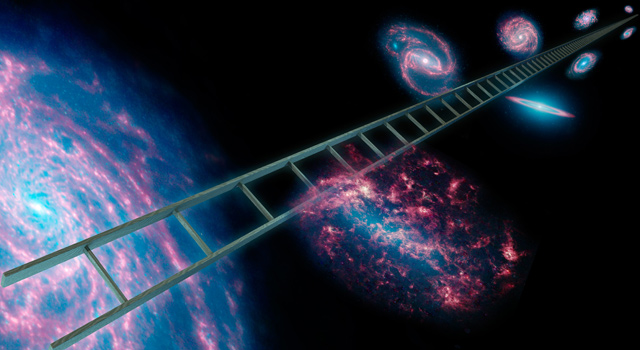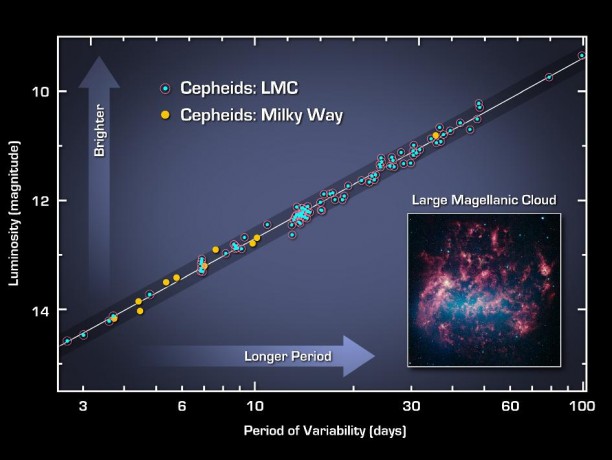Spitzer improves measurement of Universe’s expansion rate

NASA’s Spitzer space telescope’s latest achievement is most precise measurement of universe’s expansion rate, also known as Hubble constant. As per JPL’s press release, it improves by a factor of 3 on a similar, seminal study from the Hubble telescope and brings the uncertainty down to 3 percent, a giant leap in accuracy for cosmological measurements. The newly refined value for the Hubble constant is 74.3 plus or minus 2.1 kilometers per second per megaparsec. A megaparsec is roughly 3 million light-years. Michael Werner, project scientist who has worked on the mission since its early concept phase more than 30 years ago at Jet Propulsion Laboratory in Pasadena, Calif said,
“Spitzer is yet again doing science beyond what it was designed to do. First, Spitzer surprised us with its pioneering ability to study exoplanet atmospheres,” said Werner, “and now, in the mission’s later years, it has become a valuable cosmology tool.”
Spitzer space telescope, being able to capture long-wavelength infrared light, has advantage over Hubble space telescope which views cosmos in visible light. According to Glenn Wahlgren, Spitzer program scientist at NASA Headquarters in Washington, infrared vision sees through dust to provide better views of variable stars called cepheids. Cepheids are crucial to the calculations because their distances from Earth can be measured readily. In 1908, Henrietta Leavitt discovered these stars pulse at a rate directly related to their intrinsic brightness. This enabled Spitzer to improve on past measurements of the Hubble constant. Wahlgren said,
“These pulsating stars are vital rungs in what astronomers call the cosmic distance ladder: a set of objects with known distances that, when combined with the speeds at which the objects are moving away from us, reveal the expansion rate of the universe”.

But why is observing Cepheids important?
To visualize why this is important, imagine someone walking away from you while carrying a candle. The farther the candle traveled, the more it would dim. Its apparent brightness would reveal the distance. The same principle applies to cepheids, standard candles in our cosmos. By measuring how bright they appear on the sky, and comparing this to their known brightness as if they were close up, astronomers can calculate their distance from Earth.
10 cepheids observed by spitzer are in our own Milky Way galaxy whereas 80 are in a nearby neighboring galaxy called the Large Magellanic Cloud. The Spitzer research team was able to obtain more precise measurements of the stars’ apparent brightness, and thus their distances. These data opened the way for a new and improved estimate of our universe’s expansion rate. Findings were combined with published data from NASA’s Wilkinson Microwave Anisotropy Probe to obtain an independent measurement of dark energy, one of the greatest mysteries of our cosmos. Dark energy is thought to be winning a battle against gravity, pulling the fabric of the universe apart. Research based on this acceleration garnered researchers the 2011 Nobel Prize in physics.
Wendy Freedman, lead author of the new studyat Carnegie Institution for Science in Pasadena said,
“This is a huge puzzle. It’s exciting that we were able to use Spitzer to tackle fundamental problems in cosmology: the precise rate at which the universe is expanding at the current time, as well as measuring the amount of dark energy in the universe from another angle.”
The study appears in the Astrophysical Journal. Freedman’s co-authors are Barry Madore, Victoria Scowcroft, Chris Burns, Andy Monson, S. Eric Person and Mark Seibert of the Observatories of the Carnegie Institution and Jane Rigby of NASA’s Goddard Space Flight Center in Greenbelt, Md.
Featured image: NASA/JPL-Caltech

Commenting rules and guidelines
We value the thoughts and opinions of our readers and welcome healthy discussions on our website. In order to maintain a respectful and positive community, we ask that all commenters follow these rules:
We reserve the right to remove any comments that violate these rules. By commenting on our website, you agree to abide by these guidelines. Thank you for helping to create a positive and welcoming environment for all.